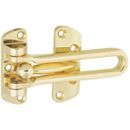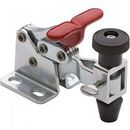Improving the airtightness of an average entry door
It’s been cold this week, and I’m fighting drafts around my doors. Most doors have the same air sealing method, involving a foam kerf seal. It’s an inexpensive and robust design. (Remember the Stanley magnetic seals?- those were tight, but made of conductive steel). http://www.homedepot.com/p/Frost-King-E-O-1-in-x-7-ft-Brown-Replacement-Foam-Kerf-Door-Seal-DS7B-25/100017658
The problem is that the door is not held tightly enough against the seals. But if you use the deadbolt to hold it tight, the deadbolt can be difficult to operate, and it will wear out faster.
For added security you might want to add a “security guard” anyway.
I’m thinking of solving the problem by installing a T-handle clamp that would press the door tightly against the kerf seal and provide the added security of door security guard.
Has anyone done something like this? Does someone make something better looking?
GBA Detail Library
A collection of one thousand construction details organized by climate and house part











Replies
You have a latch, operated by the door knob, and a deadbolt. The latch should hold the door tightly against the weatherstripping, and the deadbolt should move freely. Some strikes plates are designed with a small tongue that can be bent outward a bit to make the door close more tightly. It not, you have to move it slightly toward the stops. Once you do that, you may have to adjust the deadbolt.
I would also like an answer to this problem. The manufactured quality of lock sets and weather stripping doesn’t match the quality of the weathization of houses these days.
I looked high and low for an adjustable striker plate and ordered a few; but they loosen up with use.
I use adhesive backed rubber that is compressed by the door when the deadbolt is engaged. Its 1 ½ inch, so it wraps the jambs and the face frame. But it does not hold the door into the jamb
Here is one deadbolt system that claims to respond by holding a hard closed door tight to the stops.
http://www.sure-strike.com/
High quality EPDM adjustable gaskets jamb to the door held in place by the deadbolt. Still passive and does not pull the door, it push against the lock.
http://www.tmhardware.com/Door-Gaskets/
The only thing that pushes the door to the jam is a cam or compression lock but can only be opened form the inside
http://www.southco.com/en-us/e3
David, Thanks for clarifying the purposes of each of the pieces of hardware. I wonder if they make a tool designed to bend that tab in place? Nowadays, those tabs have become pretty flimsy, but I bet I could source a heavier gauge strike plate.
And for those of you who were ignorant like myself:
https://www.youtube.com/watch?v=oBaK8b1ljEg
here's the deal with those seals They have a somewhat limited squish range. once they are compressed enough to seal, the amount of force required to further compress them increases dramatically.
The answer is to put them on adjustable seal carriers[simply a piece of wood with a saw kerf in it] so that you can carefully adjust the amount of squish to accommodate the door warpage
An adjustable strike does not work because you need to over compress parts of the seal and the effort gets too high
My front door was set up when new such that if you pulled on it even slightly from the inside[a natural tendency since you are pulling it to open] it would not open. Turn the lever gently, it opens right up. It has loosened a bit since then.
Keith, I agree that even a high quality prehung door could have the problems you describe.
If a manufacturer provided adjustable stops, however, it would be like saying, "Here you go, adjustability because we know our doors will warp and you will no doubt twist the jamb during installation."
Has anyone seen a door with this feature? It might not add that much to the cost because they could increase their manufacturing tolerances.
The best & most expensive answer is a mutli-pt lock. And not easy to retrofit either.
A less expensive, but way more finicky, option is to try shimming the sealing lip of the wrapped foam weatherstripping closer to the door panel.
I've seen this done by slipping something like a small diameter foam backer rod or foam tape into the fold of the wrapped foam weatherstripping. This has the effect of increasing the 'reach' of the wrapped foam kerf seal. Certainly not an ideal solution....but perhaps worth a try.
Good Luck.
Stephen Thwaites
Thermotech Fiberglass Fenestration
A multi point door lock will hold the door tight and in place, and against transient, temperature and humidity driven warping. But as said, it takes a new door and frame to make happen:
http://www.hmidoors.com/entry-doors/options/multi-point-lock/
Before that miltipoint solution I will try the adjustable door gaskets: <> They make for a wider jamb and I asume an increased suface area might make for better performance of the accompanying wider weather stripping.
Can anyone recommend a decently stong striker plate and a way to attach it so it holds up and in place under increased pressure. Problem with striker plates is the degrading fo the screw holes and narrow anchor point, resulting it the plate not holding firm.
There just is not a good solution out there yet. I would like to see a substantial metal plate to mount in the frame with an adjustable slot for the deadbolt, not these ineffective surface mounted plates. They coudl be factory installed on door frames..
I don't recall saying door mfg would do this. They do not do it because it doubles the part count and triples the labor involved in assembling a door. I did this on a fixed door frame that is integral to the house
What would be a good idea is a more compliant standard door gasket, one that upon reaching the desired preload moves in a linear fashion without exponential force.
now you have your idea, go design it.....
The Therma-Tru doors that I installed in our house came with a 2 piece adjustable strike plate. They seem to work good so far. Maybe you could order and retrofit their version of a strike plate.